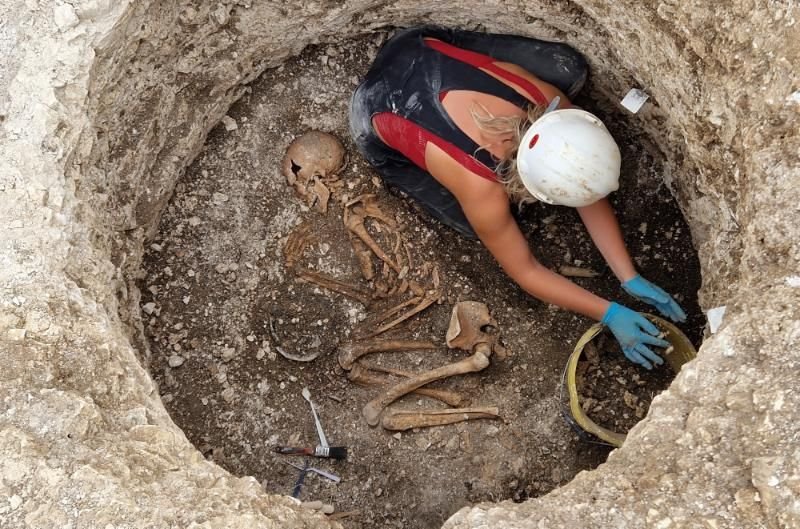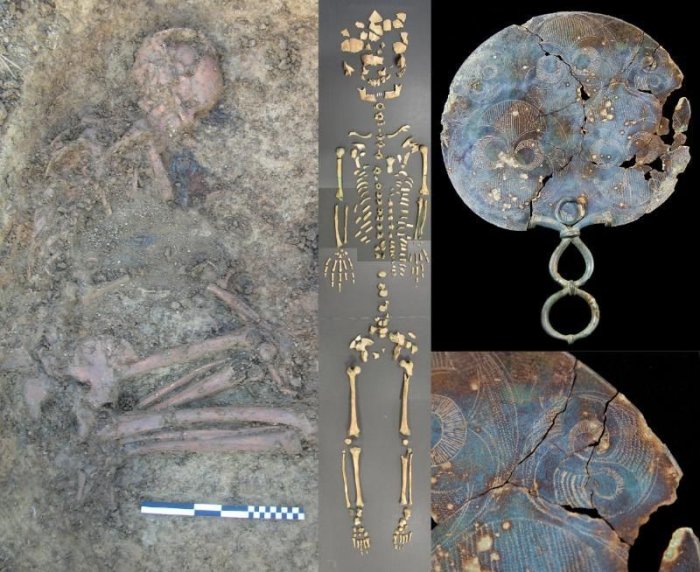Conny Waters - AncientPages.com - An international team of geneticists, led by researchers from Trinity College Dublin and accompanied by archaeologists from Bournemouth University, found evidence that the structure of British Iron Age society centered around bonds of female-line descent.
A female researcher, from above, excavating a Late Iron Age Durotriges burial at Winterborne Kingston. Copyright Bournemouth University.
Women were in power both politically and socially, the study’s results show.
The researchers conducted a comprehensive DNA sequencing study on numerous individuals from a single community. They successfully retrieved over 50 ancient genomes from burial sites located in Dorset, southern England, which were utilized both prior to and following the Roman Conquest of AD 43.
The findings of this study indicate that the community was predominantly organized around matrilineal descent. These ancient genomes provide valuable insights into an Iron Age society that was centered on women.
"This was the cemetery of a large kin group. We reconstructed a family tree with many different branches and found most members traced their maternal lineage back to a single woman, who would have lived centuries before. In contrast, relationships through the father's line were almost absent," said Dr Lara Cassidy, Assistant Professor in Trinity's Department of Genetics, who led the study.
"This tells us that husbands moved to join their wives' communities upon marriage, with land potentially passed down through the female line. This is the first time this type of system has been documented in European prehistory and it predicts female social and political empowerment.
"It's relatively rare in modern societies, but this might not always have been the case."
Durotrigian burial of a young woman from Langton Herring sampled for DNA. She was buried with a mirror (right panels) and jewellery, including a Roman coin amulet showing a female charioteer representing Victory. Image credit: Bournemouth University.
The team discovered that "matrilocality" wasn't limited to Dorset. Reviewing genetic surveys from Iron Age Britain, they consistently found the same pattern in other cemeteries, despite smaller sample sizes.
Dan Bradley, Professor of Population Genetics in the Department of Genetics at Trinity, and a co-author of the study, stated: "In our research across Britain, we observed that many cemeteries contained individuals who were maternally descended from a limited number of female ancestors. Notably, in Yorkshire, a predominant matriline was established prior to 400 BC. This widespread phenomenon revealed unexpectedly deep historical roots on the island."
Iron Age cemeteries with well-preserved burials are uncommon in Britain, but Dorset stands out as an exception. This is attributed to the distinctive burial customs practiced by the inhabitants of the region, known as the "Durotriges" by the Romans.
Researchers collected DNA samples from a site near the village of Winterborne Kingston, colloquially referred to as "Duropolis." Archaeologists from Bournemouth University have been excavating this site since 2009. Prior observations by the team indicated that the more elaborately furnished Durotrigan burials were predominantly those of women.
Beyond the field of archaeology, our understanding of Iron Age Britain has largely been derived from Greek and Roman authors. However, these sources are not always deemed entirely reliable. Nevertheless, their observations regarding British women are particularly noteworthy in the context of recent discoveries.
Charles Hamilton Smith, Boadicea, Queen of the Iceni, engraved by Robert Havell, senior, Hand-coloured etching with aquatint, 390 mm x 300 mm ©Royal Academy of Arts, London.
Upon their arrival, the Romans were taken aback to encounter women in positions of authority. Notably, two of the earliest documented leaders were queens—Boudica and Cartimandua—who held command over armies, according to Dr Miles Russell, the excavation's director and co-author on the study.
It has been proposed that the Romans may have overstated the freedoms enjoyed by British women to depict a society perceived as untamed. However, evidence from archaeology and recent genetic studies suggests that women held significant influence in various aspects of Iron Age life. Indeed, it is plausible that maternal lineage played a crucial role in shaping group identities during this period.
One of the project’s bone specialists, Dr Martin Smith, commented on the results of the study saying that “these results give us a whole new way of looking at the burials we are uncovering with our students. Rather than simply seeing a set of skeletons, hidden aspects of these people’s lives and identities come into view as mothers, husbands, daughters and so on.”
“We also see these folk had deep knowledge of their own ancestry – multiple marriages between distant branches of this family occurred and were possibly favoured, but close inbreeding was avoided.”
Drawing parallels with the writings of Julius Caesar, researchers have unveiled evidence of Iron Age migration into coastal southern England—an aspect previously overlooked in genetic studies. This groundbreaking discovery is poised to intensify discussions about the introduction of Celtic language in Britain, offering fresh insights that could reshape our understanding of historical migrations and cultural transformations.
According to Dr Cassidy, "migration into Britain during the later Bronze Age has previously been detected, leading some to hypothesise that Celtic language arrived during this period. But our results point towards substantial cross-channel mobility during the Iron Age as well. Narrowing down the arrival time of Celtic will be difficult. Indeed, it is quite possible that Celtic languages were introduced to Britain on more than one occasion."
Written by Conny Waters - AncientPages.com Staff Writer








